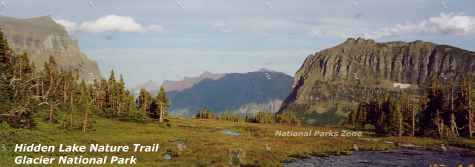Glacier National Park
Montana's Glacier National Park, located on the Canadian border, is home to the famous Going-
Montana
2002, 2019
About The Park
Glacier was a park that was high on my list of parks that I want to revisit and I did so in 2019. It’s a bit off the beaten track, located in northwestern Montana along the Canadian border. The name on the National Parks brochure is Glacier-
Waterton Lakes is only accessible from Canada and is a much smaller National Park than Glacier. Waterton Lakes borders Glacier National Park on its very remote northern border. These parks are practically inaccessible to each other from within each park unless you are truly motivated and an experienced backpacker. You have to cross the border into Canada to drive into Waterton Lakes.
Glacier National Park has less than about 70 miles of road in a park that is 1,583 square miles (4100 km²). With the Going-
The main attraction of Glacier National Park is the spectacular Going-
The highlight of the Going-
This amount of snow, the freezing, thawing, and avalanches take a terrible toll on the road and there’s been ongoing construction since 1983. The avalanches frequently take out the guard rails, small stone walls and occasionally small boulders, positioned to keep cars from going over the side. The result is a lack of protective barriers in certain places where the drop offs can be significant.
The park currently has about 25 glaciers, down from around 150 about 100 years ago, but most of these are in the back country and require considerable effort to get to. The best opportunity to see a glacier from the road is from the Jackson Glacier overlook on the Going-
If you don’t want to drive the Going-
Additionally, Glacier's Going-
A seasonal hiker’s shuttle is run by Xanterra and charges a fee.
The weather can be highly variable. Warm and sunny can change to cold and blustery very quickly. Just outside the park boundary, the town of Browning, Montana holds the world record for a temperature drop of 100°F in one day (+44° to -
Wildlife
The remoteness of the park helps to support a substantial population of grizzlies, black bears, wolves, lynx, bald eagles, mountain lions, mountain goats, elk, bighorn sheep, and many smaller species. Hiking trails frequently have warnings about grizzlies (and occasionally mountain lions) and you should know what to do if you are lucky enough to encounter one.
Lodging
There is ample lodging in the park some of which was built by the Great Northern Railroad. The railroads built lodges and ran lines into national parks as a way of generating business. It was a symbiotic relationship benefiting the public, the National Parks Service and the railroads.
Glacier Park Lodge
The Glacier Park Lodge, like the El Tovar Lodge in the Grand Canyon (built by the Atchison, Topeka & Santa Fe Railway), sits right across from the railroad station. Many of the spur lines have long since been abandoned. A National Parks Service paper on the history of railroads and the National Parks can be read here.
The Glacier Park Lodge is known as the Big Tree Lodge due to the giant three story high lodgepole pines that hold up the roof and dominate its spectacular lobby area. Even if you don’t stay at this lodge it is certainly worth taking the drive to go and see it. There are interesting displays in the lobby of the park’s early history and the stars from Hollywood’s golden era that stayed there.
Many Glacier Lodge
Between the two trips we spent four nights here and spent two nights in the Many Glacier area at the Many Glacier Lodge. The Many Glacier area, on Swiftcurrent Lake, surrounded by glaciers was far more scenic and with some nice hiking trails. The lodge wasn’t nearly as dramatic as the Glacier Park Lodge but more than adequate. National parks lodges can vary fairly widely as far as modern conveniences, amenities and price but the bottom line is you always want to stay in the park if you can. Not having a TV, or Wi-
Hiking
Glacier has numerous hikes all over the park from very short wheelchair accessible paths to multi-
Hidden Lake Nature Trail
The Hidden Lake Nature Trail, located behind the visitor center at Logan Pass, is a beautiful and easy hike with a boardwalk for about the first half-
Apikuni Falls hike
A short but rewarding hike in the Many Glacier area is the Apikuni Falls hike. It is short out-
Rafting
When I was there we took a half day rafting trip down the Flathead River. For the most part this was an easy float but scenic and removed from the cars and people. The picture in the photo gallery was the one point on the trip where there was a possibly class 2 rapids and they had a camera person situated where they could get the action picture. The picture looks good but it wasn’t typical of the trip. If you’re looking for white water rafting I’m sure there are places in the Glacier area where you can find it but this wasn’t one of them.
A Bit of Garden Wall History
A Ranger told me an interesting story about the construction of the Going-
The road was completed in 1932 and generations of drivers have benefited from the vision of the Director and his architect.
Glacier National Park Photo Gallery
Other Resources
Glacier National Park on the National Parks Service website -

Other National Parks Within a Day’s Drive
Yellowstone National Park You can see the Old Faithful geyser, mud pots, steam vents and magnificent wildlife in this park which is 455 miles and about a 7.5 hour drive to the south.
*N*P*Z*

Updated 02/11/23 7:04 PM
National Parks Zone